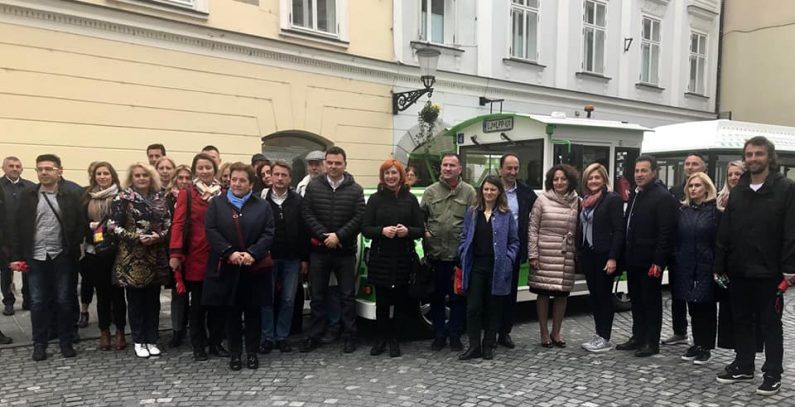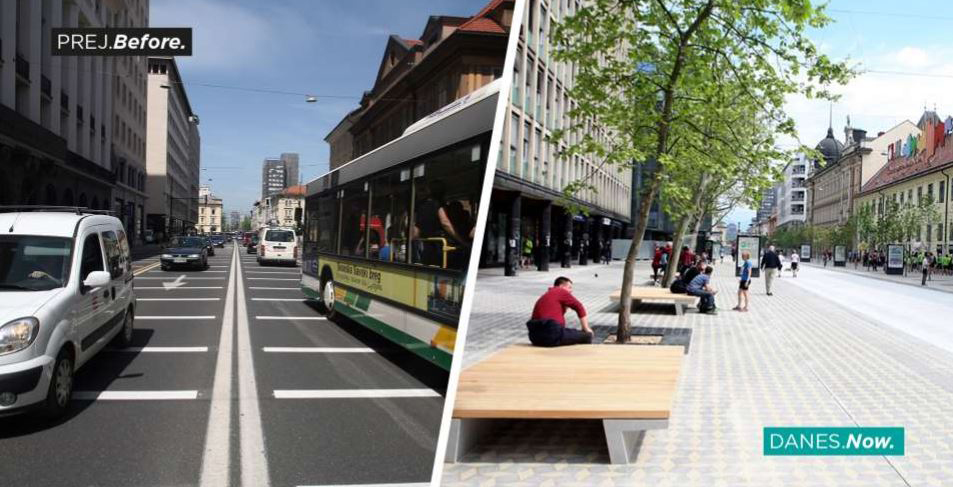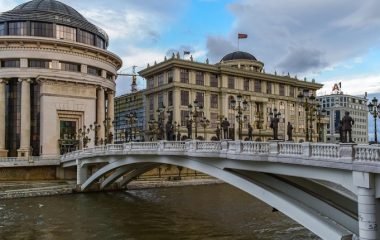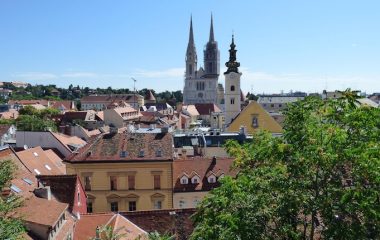
Photo: GIZ ORF-EE
Slovenia has been for more than a decade a regional champion in the promotion of sustainable urban mobility in the region of South-East Europe. In particular its capital Ljubljana. No surprise, then, that the GIZ Open Regional Fund for South-East Europe – Energy Efficiency chose it for a study trip on urban mobility.
Using a tested method which already proved as a successful one in its work with parliamentarians from across the region on introducing and improving important topics, the GIZ Open Regional Fund for South-East Europe – Energy Efficiency (ORF-EE), in addition to activities in parliaments, organized a study tour to enable MPs to get acquainted with the concept of sustainable urban mobility through an example of good practices found in Ljubljana and Slovenia.
Marina Pendeš, BiH, HDZ, delegate at the House of Peoples of Bosnia and Herzegovina
The study trip to Ljubljana will certainly be useful in my work as a delegate at the House of Peoples of Bosnia and Herzegovina if an initiative has not been launched, and I am not aware that it has, to adopt either a law or some urgent strategy that would be compulsory at all levels in BiH. Ljubljana’s experience can certainly be applied on the municipal level, as well as in several cities in BiH, such as Banja Luka, Mostar, and Tuzla, which should definitely take advantage of Ljubljana’s experience in using ecologically acceptable means of transportation that would provide safety to both pedestrians and cyclists, improve health, and reduce pollution. We also had the opportunity to see how the city of Ljubljana handles waste disposal, and these are experiences which would certainly be beneficial to our local communities, and which we can share.
Besides 14 MPs from six parliaments in the SEE region, the delegation also included seven representatives of parliamentary bodies, as well as six representatives of civil society organizations implementing the School of Political Studies program.

Ljubljana – the European Green Capital and a city tailored to its population
The city administration, headed by Mayor Zoran Janković, has managed to make this city, small by area and population (about 300,000 inhabitants), a pleasant place to live and work, but also a place whose beauties attract growing numbers of tourists from all over the world.
But if we ask ourselves what makes Ljubljana so irresistible, and what makes it a city tailored to its population, we will agree the answer lies in a range of urban planning, architectural, social, and cultural solutions that the city authorities have thought through and implemented while respecting the concept of ecological, green, and sustainable development.
Niko Peleshi, Committee on Productive Activity, Trade and Environment, Parliament of Albania

I have very positive impressions about the way this study tour has been organized. The topic is very important for our countries. For my country, Albania, it comes at the right time since we have already approved the National Development Plan for Albania. In a couple of months, we will finalize development plans for all 61 municipalities and it is the right time to integrate sustainable urban mobility plans into those plans. In Albania we recorded enormous increase in the number of cars, the public transportation is not everywhere well organized and we implemented the national program to introduce more pedestrian friendly areas in our cities and municipalities, but this was not done in a holistic way.
What we saw in Ljubljana and found out from the Ministry of Infrastructure, they made a plan and implemented it. We did it the other way round – we made hard interventions in the city centres, introduced pedestrian zones in the cities and towns, we managed to create awareness of the need to make big cities more friendly to the pedestrians. However, now is the right time to make it more professional and systematic and support municipalities to make their plans. For me and my colleagues, this experience is very important and of course we will bring our findings and information back to our countries and governments and push and encourage local municipalities to start developing SUMPs as soon as possible.
The crowning achievement of these efforts is the selection of Ljubljana as the European Green Capital for 2016. Welcoming the guests from around the region at the Town Hall, Mayor Zoran Janković said: “This prestigious title awarded by the European Commission is a great honor for us and the greatest recognition of our efforts to achieve our goal – to ensure a high quality of life for our citizens in a beautiful and healthy environment.”
A city of cars turned into a city of pedestrians and cyclists
Before Ljubljana began to transform significantly and apply the sustainable urban mobility model in 2007, the city center was congested with automobiles and buses. Residents of Ljubljana like to make a comparison between this gloomy, grey picture and today’s beautiful, green and well-maintained city. Today, the city center is reserved for pedestrians and cyclists, with the area closed for automobile traffic spanning as much as 13 hectares. Closing the center for traffic overnight was initially met with angry reactions, but today, Ljubljana residents not only enjoy their city, but they also support further development in this direction and the expansion of car-free zones and green areas. Moreover, the city administration has since learned how important it is to have a good and open communication with citizens.
Joachim Gaube, Sector Fund Manager, GIZ ORF-EE
The relaxed, yet working atmosphere during the study trip supports technical discussion among all six countries. And this is a huge achievement for the population of our partner countries. We are confident that this regional exchange between the experts from the working groups in the parliaments will continue in the future as it was for the energy efficiency law between Kosovo and Montenegro, and the recently held bilateral discussion on sustainable urban mobility between parliamentarians of North Macedonia and Kosovo, as well as between Albania and Montenegro. This development of regional exchanges is really encouraging and will accelerate development in each country.
The banks of the Ljubljanica river used to be neglected parking spaces, but today they are beautiful, developed areas, lined with cafes, restaurants, markets, and parks. Nine bridges were reconstructed or built with the aim of making the area around the river a place that would attract both locals and tourists.
The main objective of the SUMP until 2020 in Ljubljana is for two-thirds of its citizens’ pathways to be carried out in a sustainable manner (walk, bicycle, public transportation) and one-third by cars.
The parliamentarians also had the opportunity to witness a large number of electric cars on Ljubljana streets and find out that the city is well-covered by a network of charging stations. The first billboard a visitor sees leaving the airport reads: “The first electric Audi has arrived.” Such a large proportion of electric automobiles is not surprising given that Slovenia approves subsidies of EUR 5,000 to citizens who choose to buy an electric car, currently the highest such subsidy in Europe.
A new “sharing” concept – let us share bikes and cars
Slovenia’s capital has both bike-sharing and car-sharing services. Car-sharing in this Green Capital covers exclusively electric automobiles. The service is advertised as an efficient way to cut mobility costs and manage them more easily.
Jasna Sekulović, Project Manager, GIZ ORF-EE
This is the first study trip for parliamentarians on the topic of sustainable urban mobility that the GIZ ORF EE has organized.
The reactions of parliamentarians are especially positive, and even though this topic on the practical level belongs more to the local level, the participants of this study trip have recognized possibilities of how they can support through their work and contacts the operationalization of the possible urban mobility solutions in the places where they live.
After paying the initial membership fee of EUR 29, a member pays only when using a car. The price includes all costs, such as insurance, maintenance, “fuel“ or electricity, as well as free parking at certain locations.
This concept of sharing fits well into the sustainable urban mobility concept, which entirely shifts the urban mobility paradigm and sees walking as the most preferable way of moving around. Cycling comes next, followed by public transportation, while driving a car is considered the least desirable form of mobility.

Sustainable urban mobility at the national level
Ljubljana is not alone in this important enterprise. Since 2004, when Slovenia became involved in the EU’s sustainable urban mobility movement, 77 municipalities, out of a total of 212, have adopted Sustainable Urban Mobility Plans (SUMPs), with the national program also updated and improved.
Polona Demšar Mitrovič of the Slovenian Ministry of Infrastructure explained that funding for these projects has come from the EU’s Cohesion Fund, but that the country will switch to its own financing from 2020, in what will create the need to pass national laws to regulate this field. “Adopting regulations, financing, as well as knowledge, make up a framework for a comprehensive approach,” said Demšar Mitrovič, adding that the implementation of this concept also requires soft measures in managing mobility, such as adopting mobility plans for institutions and sustainable parking policies, adapting the city’s logistics, educating and raising awareness among the target publics, and carrying out campaigns.
20% of Ljubljana’s city administration employees cycle to work.
The Slovenian capital has succeeded in this enterprise, while countries and cities in the region are yet to adopt their own plans. The GIZ ORF-EE is already helping Tirana, Podgorica, and Sarajevo to develop these plans, and will soon start educating local experts that other cities and municipalities in the region would be able to engage to support them in this important work. After all, why wouldn’t every city, just like Ljubljana, be tailored to its population?









Be the first one to comment on this article.